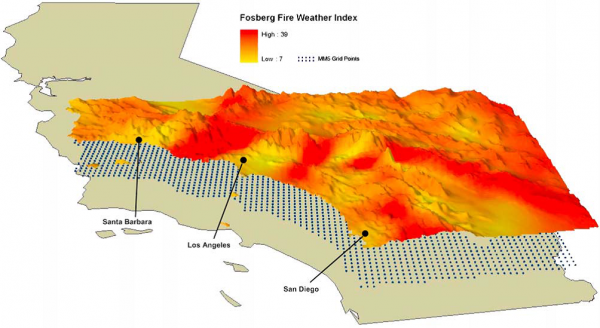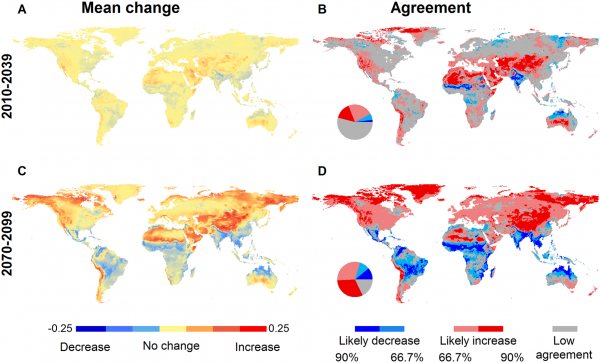3 May 2013
Challenging but crucial: linking science to solutions
Posted by mcadams
By Max Moritz
Conducting fire-related research in California can be far from “academic.” Like many scientific endeavors, it means tackling difficult questions about human interactions with the environment, and more importantly, figuring out how to effectively inform potential solutions by connecting that science to decision-makers. This connecting is a key function of the University of California Cooperative Extension, of which I am a part.
Regardless of their discipline, many researchers view the problems they study and their solutions through a specific lens: if we just figure out the patterns, processes, and cause-and-effect relationships, then … problem solved! Clearly, this is not the case. The challenges of translating research for policy makers, planners, and the general public are as complex and important as the scientific questions themselves.

This mapped surface shows the average severity of fire weather conditions during Santa Ana wind events, which are associated with some of the largest California fires on record. Image copyright American Geophysical Union.
In both local and global fire-related research, scientists debate the same types of questions. What’s causing a particular outcome? At the landscape scale, there are long-standing scientific debates about whether larger or more severe fires are primarily due to fuel (e.g., characteristics of live and dead vegetation) or weather (e.g., extreme wind patterns) in different locations.
At the global scale, parallel arguments are debated. Will fire activity respond to climate shifts relatively quickly, or will vegetation change first and entrain changes in fire along with it? Contrasting views stem from different disciplinary training or research experience, but at their core, such debates boil down to scientists arguing about which mechanisms will dominate a system’s dynamics: bottom-up (fuels) or top-down (weather/climate).
Despite the parallel questions being asked at different scales, the degree to which this science is reflected in decision-making across scales is much more variable and nuanced.
At local levels, we tend to have a lot of science about fire – its behavior under varying conditions, the fire ecology of different species, or why homes burn – that has yet to effectively make its way into policy, urban planning, or ecosystem management. (The outdated or overly simplified assumptions causing these disconnects are frustrating, but that is the nature of so many applied scientific problems.) Some decision-makers may feel overwhelmed by the growing volume of research, much of which appears to present conflicting views, and they can eventually view the science as unhelpful.
To address this, there are now coordinated efforts to synthesize and disseminate fire-related information. In California, for example, we have a Fire Science Consortium, one of several such consortia across the U.S. funded by the Joint Fire Sciences Program. These are important vehicles for connecting locally relevant research to managers and the public.
The effect of global-scale influences on fire, especially in the context of climate change, leads to a totally different set of outreach opportunities and challenges. For one thing, people are generally concerned about future interactions between fire and climate change. Despite the uncertainties in future climate projections, decision makers at many levels want more information. Fortunately, we have ways to address these inherent complexities and model future outcomes, providing potential scenarios for policy consideration.

Many people don’t realize that there are multiple global climate projections being produced by various labs and agencies, and we don’t know which model will come closest to simulating the actual future climate. The mean change in fire probability (left panels) should thus be interpreted along with model agreement maps (right panels), providing a measure of uncertainty among projections. Photo credit: http://www.esajournals.org/doi/abs/10.1890/ES11-00345.1
Because climate-vegetation-fire models are still being refined, however, we are probably years away from definitive predictions of how frequencies, sizes, or severities of fire may change in a given location. Big questions remain unanswered. How should climate change adaptation efforts for fire accommodate multiple possible futures? What if short-term adaptation measures conflict with long-term ones or with greenhouse gas mitigation goals?
Of course, things can always get more complicated. As we learn more about climate change and fire and how societies can adapt to an unknown future, we continue to discover insights into the roles of fire on the landscape. New science about how variable natural fire regimes may be must also be integrated into the mix. Many of the questions being asked are new. Some of the puzzle pieces are still taking shape. But we don’t have the luxury of waiting until everything appears settled to engage with decision-makers.
As I started this post, effective science is not just about addressing challenging research questions. It’s about putting the answers to those questions to good use. Moving forward, it will be essential for scientists to be active participants in identifying and achieving sustainable solutions. We cannot do that without listening to what our communities need from us, and we cannot supply what they need without engaging in relevant decision-making processes. Although these might not be the skills we learned in grad school, they may ultimately be the most important of all.
Max Moritz is a Cooperative Extension specialist focusing on California’s fire ecology and management in the department of Environmental Science, Policy and Management at the University of California, Berkeley.
On April 30, COMPASS published a commentary in the journal PLOS Biology on the journey from science outreach to meaningful engagement. This post is part of a series of reactions, reflections, and personal experiences expanding the conversation. Read the summary post here, and track the conversation on Twitter by searching for #reachingoutsci.
COMPASS is an organization that coaches scientists to be better communicators; brokers connections among scientists and between scientists, policymakers, and journalists; and leads communications trainings, including for the Leopold Leadership Program.










 The Plainspoken Scientist is the science communication blog of AGU’s Sharing Science program. With this blog, we wish to showcase creative and effective science communication via multiple mediums and modes.
The Plainspoken Scientist is the science communication blog of AGU’s Sharing Science program. With this blog, we wish to showcase creative and effective science communication via multiple mediums and modes.